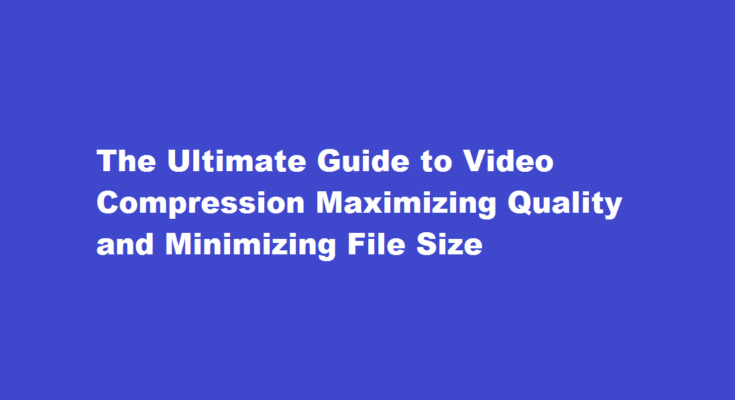Introduction
With the rise of video content creation and consumption, the need for efficient video compression has become crucial. Compressing videos not only helps save storage space but also ensures smoother streaming and faster sharing. In this article, we will explore the fundamentals of video compression and provide you with practical tips to achieve optimal compression while maintaining excellent video quality.
Understanding Video Compression
Video compression is the process of reducing the file size of a video while preserving its visual quality. It involves removing redundant or unnecessary data from the video to make it more manageable without significant degradation. Compression algorithms use various techniques like spatial and temporal redundancy reduction, quantization, and entropy encoding to achieve this goal.
Choosing the Right Video Format
Selecting the appropriate video format is essential to achieve efficient compression. Different video formats use different compression algorithms, resulting in varying levels of quality and file sizes. Popular video formats include H.264, H.265 (also known as HEVC), and VP9. H.264 is widely supported and provides good compression, while H.265 offers even better compression but requires more processing power. VP9 is an open-source alternative to H.264 and H.265, offering competitive compression and compatibility.
Resolution and Frame Rate Optimization
The resolution and frame rate of a video significantly affect its file size. Reducing the resolution and frame rate can substantially reduce the video’s size while maintaining acceptable quality. Consider the intended usage of your video and the viewing devices when deciding on the optimal resolution and frame rate. For example, if your video is intended for web streaming, a resolution of 720p or 1080p at 30 frames per second (fps) is generally sufficient.
Bitrate Adjustment
Bitrate controls the amount of data used to represent each second of a video. Lower bitrates reduce file size but may result in loss of quality, while higher bitrates preserve more detail but lead to larger files. Finding the right balance is crucial. For videos with static content, a lower bitrate may be acceptable. On the other hand, videos with fast-moving scenes or complex visual content may require higher bitrates to maintain clarity.
Keyframe Interval and GOP Size
Keyframes, or intraframes, are complete frames stored independently within a video stream, while the remaining frames are predicted based on these keyframes. Adjusting the keyframe interval and GOP (group of pictures) size affects compression efficiency. Longer intervals and larger GOP sizes result in better compression but reduce seekability and editing flexibility. Conversely, shorter intervals and smaller GOP sizes offer more precise seeking but increase the overall file size.
Transcoding and Video Editing
Transcoding is the process of converting a video from one format to another, often to achieve better compression. If you need to edit or modify a video, it is recommended to perform the editing on the uncompressed or lightly compressed original file before applying compression. Repeated compressions can degrade video quality further, so it’s best to minimize unnecessary transcodes.
FREQUENTLY ASKED QUESTIONS
How do I compress a video quickly?
If you need to send a video over email, the simplest method is to compress the video file into a ZIP file. If you’re on Mac, right-click on the file and select “compress [file name].” On a Windows PC, right-click on the file, then select “Send to” > “Compressed (zip) folder.”
Which one is used to compress video?
The correct answer is WMV. WMV is used as the video compression format.
What is video compression technique?
Video compression is the process of reducing the number of bits needed to represent a video without compromising its visual quality. The purpose of compression is to make the video occupy less space than the original file and to facilitate its transmission over the Internet.
Conclusion
Mastering the art of video compression is essential for content creators, streamers, and anyone dealing with video files. By understanding the fundamentals and implementing the tips mentioned above, you can achieve optimal compression while maintaining excellent video quality. Remember to choose the right video format, optimize resolution and frame rate, adjust bitrate, keyframe interval, and GOP size wisely. Additionally, be mindful of unnecessary transcodes to minimize quality loss. With these techniques, you can strike a balance between file size and video quality, ensuring an enjoyable viewing experience for your audience.
Read Also : A Step-by-Step Guide to Filing a Complaint with the Cyber Cell



